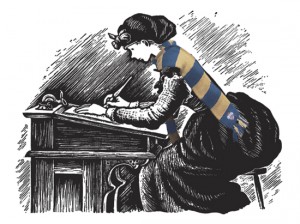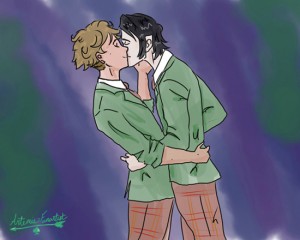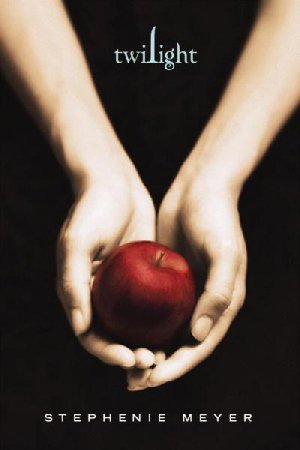Was Jo March a Ravenclaw? Authors, Fans, and Who Makes the Rules
What are Harry Potter’s kids up to? Should Jo have married Professor Bhaer? Could Bella Swan have depended less on Edward? For many readers, part of being a fan is the desire to know more than what’s spelled out on the page.
 Little Women illustration by Barbara Cooney (1955). Scarf composite by Charlotte Reber and Lolly Robinson.
Little Women illustration by Barbara Cooney (1955). Scarf composite by Charlotte Reber and Lolly Robinson.What are Harry Potter’s kids up to? Should Jo have married Professor Bhaer? Could Bella Swan have depended less on Edward? For many readers, part of being a fan is the desire to know more than what’s spelled out on the page. And when answers aren’t readily available, some readers are happy to create them for themselves.
Thus, there’s fanart, from the representational (a re-creation of a book’s cover image) to the more imaginative (a drawing of Ronan and Blue from the Raven Cycle eating ice cream together, just because). There are fan videos (the full-length parody A Very Potter Musical and its two sequels; a growing number of literary-inspired webseries), there’s fan music (an entire genre of wizard rock, or wrock, featuring bands such as Harry and the Potters and their Slytherin-leaning counterparts, Draco and the Malfoys), and there are fan playlists (mixes of unrelated songs chosen to go with everything from A Series of Unfortunate Events to the Lunar Chronicles).
And then there’s the seemingly bottomless rabbit hole that is fanfiction. In addition to the hundreds of thousands of stories based on the Harry Potter and Twilight series, there’s fanfic for The Giver, The Hobbit, The Baby-Sitters Club, and the Anne of Green Gables books. And the Warriors books (in the tens of thousands). And The Devil’s Arithmetic. And The Lorax. Fanfic lets fans take ownership of fictional worlds in any way they want. They can create prequels (“The Fifth Annual Hunger Games”), sequels (Peter Pan returns to the Darling household, but Mr. Darling isn’t having it), alternate endings (Rudy survives The Book Thief), or alternate universes (Charlie, Veruca, Mike, Violet, and Augustus attend a school detention supervised by Mr. Wonka). Anyone can write fanfic, and any such writing — anyone’s writing — has a chance to change how others think about the canonical work. It’s hard to un-see subtext once you’ve been shown it, and fanfic often infuses the work it’s based on with new subtext, romantic and otherwise. After you read a story about Tuck Everlasting’s Winnie choosing immortality and becoming an alcoholic, you might see her canonical decision not to drink from the spring in a new light.
Usually, that’s that. An author creates something, fans create something out of it, other fans (ideally) enjoy it, and everyone waits for the next book. But not always.
* * *
 Some authors are willing to engage in conversation about their stories outside the confines of their books. The final Harry Potter book had barely hit the shelves before J. K. Rowling began volunteering more information. Harry and Ron both grew up to be Aurors, she revealed just days after the release of Harry Potter and the Deathly Hallows, and Harry was head of the department. A few months later, when a fan asked if headmaster Albus Dumbledore ever fell in love, she responded that she had “always thought of Dumbledore as gay,” and that he’d been in love with the dark wizard Gellert Grindelwald. She’s even continued the Potter saga in real time on Twitter; she announced in September 2015 that Harry’s son James had just started Hogwarts and been sorted into Gryffindor. When Noma Dumezweni was cast as the adult Hermione in the play Harry Potter and the Cursed Child, Rowling tweeted: “Canon: brown eyes, frizzy hair and very clever. White skin was never specified. Rowling loves black Hermione.” To fans lamenting that they never received their Hogwarts entrance letters, she tweeted, “You went to Hogwarts. We were all there together.” She explained her claim by adapting a Dumbledore quote: “Of course it happened inside your head, but why on earth should that mean it wasn’t real?”
Some authors are willing to engage in conversation about their stories outside the confines of their books. The final Harry Potter book had barely hit the shelves before J. K. Rowling began volunteering more information. Harry and Ron both grew up to be Aurors, she revealed just days after the release of Harry Potter and the Deathly Hallows, and Harry was head of the department. A few months later, when a fan asked if headmaster Albus Dumbledore ever fell in love, she responded that she had “always thought of Dumbledore as gay,” and that he’d been in love with the dark wizard Gellert Grindelwald. She’s even continued the Potter saga in real time on Twitter; she announced in September 2015 that Harry’s son James had just started Hogwarts and been sorted into Gryffindor. When Noma Dumezweni was cast as the adult Hermione in the play Harry Potter and the Cursed Child, Rowling tweeted: “Canon: brown eyes, frizzy hair and very clever. White skin was never specified. Rowling loves black Hermione.” To fans lamenting that they never received their Hogwarts entrance letters, she tweeted, “You went to Hogwarts. We were all there together.” She explained her claim by adapting a Dumbledore quote: “Of course it happened inside your head, but why on earth should that mean it wasn’t real?”Agreed. But I would take it a step further: reader, whatever’s inside your head is just as real as what’s in Rowling’s. She can interpret Dumbledore as in love with Grindelwald; you can agree if you want, or you can choose to believe that he was in love with Hagrid, or Professor McGonagall, or both, or no one. You can decide that Harry’s kids are all Slytherins, or that Harry got fed up with magic and became an accountant. (At least until Harry Potter and the Cursed Child confuses matters with new canonical information. Sequel or not, it’s sure to be full of backstory.)
If Hogwarts is real to anyone, it’s those involved with the fan convention LeakyCon. At LeakyCon 2014, the YA authors present were asked to sort some of their characters into Hogwarts houses — using another author’s universe to create new information about their own. John Green put Hazel of The Fault in Our Stars in Gryffindor; Scott Westerfeld sorted Shay from Uglies into Slytherin; Stephanie Perkins sorted Anna of Anna and the French Kiss into Ravenclaw. Are their choices now part of their characters’ stories? Could Rowling declare Hazel a Hufflepuff? Could you or I?

 One of the authors who sorted at LeakyCon was Rainbow Rowell. Later, as part of Patrick Ness’s 2015 Save the Children campaign, she took the concept further, pledging to sort one of her characters for every thousand pounds donated and offering detailed reasoning for her choices via Twitter. Rowell explained that Fangirl’s Cath, with her devotion to reading and writing, was a Ravenclaw, and that Baz, who at that point had only appeared in brief snippets within Fangirl, was a Hufflepuff despite his resemblance to noted Slytherin Draco Malfoy. Soon after, Rowell’s Carry On was released, expanding the world of those snippets into a novel with strong echoes of fanfiction. And now there’s fanfic and fanart for Carry On, and Rowell has encouraged both and regularly re-blogs fans’ sketches of the characters. To recap: this is an author sharing fans’ interpretations of her novel…about characters who originated in fictional fanfiction…for a fictitious series (which was an affectionate parody of an existing series)…within one of her other novels.
One of the authors who sorted at LeakyCon was Rainbow Rowell. Later, as part of Patrick Ness’s 2015 Save the Children campaign, she took the concept further, pledging to sort one of her characters for every thousand pounds donated and offering detailed reasoning for her choices via Twitter. Rowell explained that Fangirl’s Cath, with her devotion to reading and writing, was a Ravenclaw, and that Baz, who at that point had only appeared in brief snippets within Fangirl, was a Hufflepuff despite his resemblance to noted Slytherin Draco Malfoy. Soon after, Rowell’s Carry On was released, expanding the world of those snippets into a novel with strong echoes of fanfiction. And now there’s fanfic and fanart for Carry On, and Rowell has encouraged both and regularly re-blogs fans’ sketches of the characters. To recap: this is an author sharing fans’ interpretations of her novel…about characters who originated in fictional fanfiction…for a fictitious series (which was an affectionate parody of an existing series)…within one of her other novels. Spoiler alert: SImon and Baz Carry On fanart by Tumblr user ace-artemis-fanartist.
Spoiler alert: SImon and Baz Carry On fanart by Tumblr user ace-artemis-fanartist.* * *
It’s easy to look at these sorts of exchanges between authors and fans as a new phenomenon. After all, Twitter never demanded that E. B. White defend the ending of Charlotte’s Web, no matter how many “feels” it engendered. There was no online “cover reveal” for Where the Wild Things Are, despite the retweets that it could have produced, and Frances Hodgson Burnett probably never typed the phrase “spoiler alert.” But authors of decades and centuries past didn’t work in a vacuum. Louisa May Alcott, for instance, heard from fans aplenty, and their comments did affect what she wrote, though not in the way most of them apparently wanted. Between the October 1868 publication of Little Women’s first part and the April 1869 publication of the second part (both now usually printed as a single volume), fans demanded a particular kind of happy ending for Jo March. In a March 1869 letter to Vassar College instructor Elizabeth Powell, Alcott spelled out her reasons for denying their request:
A sequel will be out in early April, & like all sequels will probably disappoint or disgust most readers, for publishers wont [sic] let authors finish up as they like but insist on having people married off in a wholesale manner which much afflicts me. ‘‘Jo” should have remained a literary spinster but so many enthusiastic young ladies wrote to me clamorously demanding that she should marry Laurie, or somebody, that I didnt [sic] dare to refuse & out of perversity went & made a funny match for her. I expect vials of wrath to be poured out upon my head, but rather enjoy the prospect.
And so Jo rejected handsome, young, wealthy Theodore “Laurie” Laurence and instead married Professor Friedrich Bhaer, “a funny match” indeed to a goodly number of fans. The response, according to “Childhood’s Fancies,” an 1876 article in Scribner’s by Thomas Wentworth Higginson, was “a general groan of dismay among the young women of America.” Imagine the hashtags, if those had existed at the time. Or just look for #TeamLaurie and #TeamBhaer today. And yes, now there’s fanfic in which Jo makes different choices (spoiler alert: she often picks Laurie).
* * *
By the time Stephenie Meyer’s Twilight was published in 2005, it was easy for readers to immediately, electronically, express their opinions about it. And they did. “The damsel in distress act is staler than month-old bread,” said one Amazon review. “I’ve seen jellyfish with more spine than [Bella] exhibits through most of the book,” said another. “She lets Edward dictate to her and push her around and never does more than sulk and glare.” (The book and its sequels do have legions of fans and plenty of fanfiction; famously, E. L. James’s Fifty Shades of Grey started as alternate-universe fanfiction about Bella and Edward.)

 Some authors address criticisms with tweets and blog posts. Meyer addressed hers by rewriting an entire book (albeit a decade later). The Special Tenth Anniversary Edition of Twilight came packaged in a volume with Life and Death: Twilight Reimagined, which switched the genders of most of the characters, turning human-girl Bella into human-boy Beau and vampire-boy Edward into vampire-girl Edythe. In the foreword, Meyer took on her critics: Bella was a “human in distress” who responded to the dramatic events around her as any ordinary human would, damsel or not. For most of the new novel, Meyer simply let the story play out with her male version of Bella and female version of Edward. There were small differences in their narrative voices and their tastes in books and clothes, and larger differences in the types of violence that threatened them, but really, there weren’t many major changes. See? it seemed to say to readers. Beau’s still obsessed with Edythe, and he still needs her supernatural powers to save him. The things you complained about had nothing to do with gender!
Some authors address criticisms with tweets and blog posts. Meyer addressed hers by rewriting an entire book (albeit a decade later). The Special Tenth Anniversary Edition of Twilight came packaged in a volume with Life and Death: Twilight Reimagined, which switched the genders of most of the characters, turning human-girl Bella into human-boy Beau and vampire-boy Edward into vampire-girl Edythe. In the foreword, Meyer took on her critics: Bella was a “human in distress” who responded to the dramatic events around her as any ordinary human would, damsel or not. For most of the new novel, Meyer simply let the story play out with her male version of Bella and female version of Edward. There were small differences in their narrative voices and their tastes in books and clothes, and larger differences in the types of violence that threatened them, but really, there weren’t many major changes. See? it seemed to say to readers. Beau’s still obsessed with Edythe, and he still needs her supernatural powers to save him. The things you complained about had nothing to do with gender!But — surprise! — the ending to Life and Death was drastically different from that of Twilight: an attack that Bella survived left Beau near death, and Edythe saved his life by turning him into a vampire. (In contrast, it took Bella the rest of the original Twilight series to trade in her mortality.) In the afterword, Meyer acknowledged that she’d “cheated,” explaining that the new ending was unrelated to the gender swap. “This has always just been the big what if?, and I wanted to see what it would feel like if Twilight had been the end of the story.” Meyer may have written Life and Death in part to respond to readers’ criticisms, but she had other reasons of her own. She has said herself that Life and Death is “not a real book,” and it seems one of the reasons she wrote it is similar to the reason many people write fanfiction: because when a fictional world interests you, it’s fun to play there. “This change…does not mean that I prefer it to the original or think that the original was ‘wrong,’” she wrote in the afterword. In other words, Meyer didn’t intend to create new canon or to say, Here’s how it really happened.
That’s the thing about fiction: “really” can mean whatever you want it to mean. If the author weighs in after the book has been published, you can let her influence your opinion or you can just keep reading the story your way. Extratextual opinions from authors about their own work can be interesting, but they’re no “truer” than anything readers come up with.
Including this reader’s truth: Jo March was definitely a Gryffindor.
From the May/June 2016 issue of The Horn Book Magazine: Special Issue: Collaborations. For more in our Fan Week series, click on the tag Fan Week 2016 and see #HBFanWeek on Twitter.

RELATED
RECOMMENDED
ALREADY A SUBSCRIBER? LOG IN
We are currently offering this content for free. Sign up now to activate your personal profile, where you can save articles for future viewing.







Add Comment :-
Be the first reader to comment.
Comment Policy:
Comment should not be empty !!!